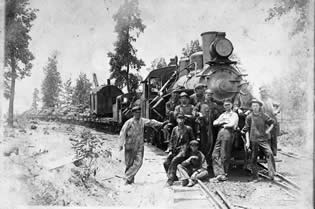 |
The History of the Davidson, Hicks & Greene CompanyBy L. Jarod Pearson
Davidson, Hicks and Greene (DH&G) was one of Cowan, Tennessee's primary industries between the years 1916 and 1928. The company began in the late 19th-Century with logging operations and hardware lumber manufacturing facilities in Fentress County and in Overton County, Tennessee, both located in the Cumberland Mountains near the Tennessee/Kentucky state line. As the cut-out period was drawing near, DH&G hired Mr. W.E. Hodges to purchase timber-land acreage in the mountains south and east of Cowan. By 1916 the company had purchased over 52,000 acres above Cowan, 8,000 of which was across the Alabama state line as far as the Walls of Jericho. The company phased out all operations in Fentress and Overton Counties and gradually relocated the employees, mules and equipment to Cowan. In 1917 the Cowan operation began with about 20 employees and 100 mules. Three sawmills were built on the site of the former Sewanee Furnace near downtown Cowan, and a standard-gauge railroad was constructed from the sawmill area to the top of the mountain.
The logging railroad was an engineering feat. The distance from Cowan to the top of the mountain was six miles and required a grade of nearly 5% to reach the 1,000 foot elevation change. The steep grade required gear-driven locomotives. Further into the mountain the company built up to 25 miles of spur track to reach the various timber ridges. Some of these tracks were incline railroads operated by cable systems. DH&G processed over 225 million board feet of lumber, but their most famous product was undoubtedly the 60 million wooden spokes shipped to Detroit for the Ford Model T automobile. The vast operation required the company to invest in housing for its employees. The first neighborhood, Slagtown, was build along the slag piles left behind by the Sewanee Furnace. The second development was The Bottom, a neighborhood for African-American employees. Chocolate Row was the third development, so named because all of the houses were painted brown. The last development was Lakeview, built in a clearing on top of the mountain. The company built a hotel in Lakeview as well as a school, Cold Springs School, built from two railroad box cars! The company railroad gave residents of Lakeview and the various logging camps easy access to Cowan's business district as well as the company office near the lumber yard. Timber companies like DH&G ordinarily built company stores to give employees convenient access to retail goods and services. DH&G had a company store in Davidson, Tennessee operated by Jim, Ellis and George Forgy. In Cowan, however, the Forgy brothers opened their own mercantile company that received business from DH&G as well as the permanent residents of Cowan. The lumber operation entered a sunset period as the Ford Motor Company switched from wooden-spoke wheels to metal and wire spoke wheels. In 1925 DH&G gradually shifted the company's focus from wood to cement, taking full advantage of the vast clay and limestone resources in the area above the sawmill. The officers of DH&G organized the Cumberland Portland Cement Company in 1926. The cement plant helped drive the town of Cowan for six decades including some of the most prosperous years in the town's history.
Franklin County Historical Review, July 1977. Pearson, Frank Sr., "History of Marquette Company," pp. 77-85. Anderton, Norma Rhea Forgy, The Forgy Department Store: A Reminiscence of Norma Rhea Anderton, October 1999.
|

